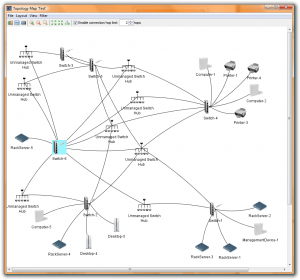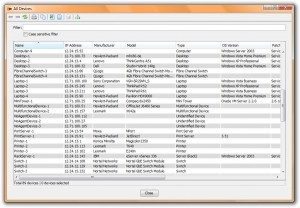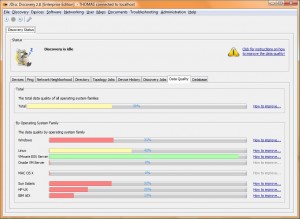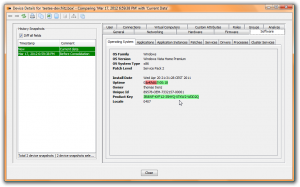Peer Reviews – ITAM Review readers sharing their opinions on ITAM tools, technology and services.![logo]()
This product review has been written by three ITAM Review readers. Our thanks to R Josey, Stephen B and R Ogilvie for taking the time to share their views on JDisc Discovery. Our reviewers have been specially selected for their experience in the IT industry and in the interests of a fair and balanced review are new to Jdisc, i.e. our reviewers are not customers or in any way affiliated with Jdisc.
JDisc Discovery
The Review Panel
![R Josey, ITSM Consultant, ?, Information Technology, 10 Assets]() R Josey, Independent ITSM Solution Architect, London “A nicely made tool, which gathers quality data without requiring agents.”
Strengths
Quick to Deploy, easy to maintain, nice gui.
Weaknesses
Not suitable for large enterprises |
![Stephen B, IT Asset Management, USA, Manufacturing, 40,000 Assets]() Stephen B, IT Asset Management, USA, Manufacturing, 40,000 Assets “A simple, small, single interface auto-discovery tool that works, but isn’t at the Enterprise level yet.”
Strengths
The functionality is there for a decent discovery tool. The tutorials online and the FAQ’s are very well maintained.
Weaknesses
I would have to go to the user interface. The best tools now are the most accessible, specifically web based, or maybe app based. This look needs a facelift. With that facelift, I think there could be a great potential for growth with this product. |
![R Ogilvie, ITSM Specialist, UK, Energy –Oil & Gas, IT Team of 100, company of 3500]() R Ogilvie, ITSM Specialist, Canada, Energy –Oil & Gas, IT Team of 100, company of 3500 “A discovery tool”
Strengths
Simplicity in that anyone could gain benefit from usage with limited technology skills
Weaknesses
Simplicity in that from an enterprise perspective this functionality may already exist in other products we use |
Ratings
The Reviews
|
R Josey |
Stephen B |
R Ogilvie |
Total |
| Would you recommend this technology? |
Yes |
Yes (if in small estate) |
Yes |
3/3 |
| Would you consider using this technology in the future? |
Yes |
Yes (If in small estate) |
Yes |
3/3 |
| Ease of use? (Out of 10) |
9 |
5 |
9 |
7.67 |
| Overall Features (Out of 10) |
7 |
7 |
8 |
7.3 |
![R Josey, ITSM Consultant, ?, Information Technology, 10 Assets]()
R Josey, ITSM Solution Architect, London, UK
R Josey: “This discovery product from the JDisc is a standard discovery tool aimed at the low to mid-market.
There are some interesting add-ons for relationship mapping, network topology mapping and tracking device history; however these were not included as a part of this review.
![Topology Map Test]()
Initial Setup
My first impression of the tool was that it is very simple to setup and get started.
A few clicks and the installer has finished and the product client GUI is launched. This process was painless and an initial scan goes off to find devices. Although I have a rather limited network to allow this server access to, I found that it did not find all devices initially.
The accompanying documentation was helpful in explaining the relevant scenarios and some network range scanning is recommended by the tool. This enabled higher device recognition on the network, although I was interested to find that it did not discover the smartphones connected.
The test network scanned included a printer, some independent laptops (not part of an AD domain), tablets and a router.
One thing I found very useful, at this stage was a report showing the effectiveness of device discovery. As with any tool of this type, the correct credentials are required to get detailed information and other issues can prevent the discovery tool getting the information required. This tool uses an agent-less and non-intrusive architecture and proved easily blocked by network devices for various reasons. The report showed all my devices which had problems and suggested ways in which this configuration could be fixed. I thought this was an excellent way to assist administrators, who may well not be experts in discovery tools and techniques, to find a way increase the quality of the discovery scans. In spite of my efforts I was unable to gather in-depth information about the windows 7 laptops on the network. My impression is that this would not be a significant issue in a windows AD environment.
Navigation and GUI
Once properly scanned, devices show a plethora of information in the device reports. These are clearly laid out and easily and intuitively navigated using the client tool GUI. I found the client to be quick and able to open multiple windows, for different reports, which could be used independently. This meant I felt free to move back to previous positions without having to constantly navigate. The exception to this appears to be when the help file is opened. This locks the other client windows, which I found quite annoying when the help file is telling you how to configure something, but you cannot see both the help and the configuration screen at the same time. However, this was the exception rather than the norm.
Overall, the navigation was simple and intuitive, the information was clearly and logically laid out and the icons and GUI design are uncomplicated and pleasant.
I would comment that this tool misses a web-based interface allowing exposure of the data to a wider audience. The documentation shows that the client could be installed on multiple client machines, as required, but I feel this is not as simple to deploy.
Reports
The tool presents all of the data collected in a series of reports. Mostly this focuses around details about devices, which has clearly had the main focus from the development effort. These are quite useful and enable detailed device information to be clearly shown. However, I feel that this may struggle to display large amounts of data in a useful and meaningful way. This is due to a lack of grouping capability on the report itself.
Grouping however can be configured to create a tree structure for the whole dataset. The documentation gives examples such as location based on subnet, but the tool has the capability to create custom conditions based on any available data attribute.
This seemed to be reasonably powerful and simple to configure and can then be used in all the other report screens.
All the data can be exported to Excel for further manipulation but I would expect more based on my experience with other toolsets in the marketplace.
Documentation
The tool comes with thorough and easy to read documentation. All key concepts for discovery are explained, including mechanisms used by other tools in the market. The descriptions as to the mechanisms the product uses were very useful and easy to absorb.
I found the information very accessible (i.e. I could find it quickly when I wanted to), clear and complete.
Architecture
The basic architecture consists of a single server, performing scans based according to a configured schedule.
The system documentation explains the system architecture well and how it acquires detailed device information with agentless / non-intrusive methods. There is a well described list of methods for the various platforms supported. In order to do this, there are a rather large number of ports which are required in order to do this. Many of these would often be closed through firewalls due to security reasons. Naturally, there are ways to create the correct rules to allow this application to perform. My personal experience suggests that this would be difficult to achieve in a large multinational organization. Discovery of data-centers is a typical challenge for these kinds of tools. The documentation mentions a separate installation could be used, behind a firewall, if required. However, there does not appear to be way to consolidate the databases and combine the data. This appears to be more of a workaround than a viable solution.
Similarly, the requirement for a device to be connected at the moment of scanning may reduce the reliability of the data due to ever increasingly flexible working practices.
Integration
Typically, I have seen these tools deployed to achieve purposes such as gathering data for software asset management, client management (e.g. patch and software installation) and configuration management. Alone, I do not see this product achieving any of these aims. There is some collection of used license keys in the data, but there does not appear to be any further SAM capability. The add-ons certainly address some of the aims of configuration management, although I have not looked further into these capabilities.
To achieve further value from the data collected I would expect to be able to integrate this with other systems. There does not appear to be any capability, out-of-the-box, however with a postgreSQL backend, I am sure this could be developed, as required.
![All Devices]()
Summary
I feel this tool is a good match for a small or medium sized company, which is looking to quickly and easily gather detailed data about the devices or assets on their network. The setup is simple does not require expertise to start getting quality data. This data can be easily accessed and exported to excel for further processing. This would enable simple asset management activities and provide useful information for IT operations teams.
I feel the platform is limited when looking at the enterprise level.”
![Stephen B, IT Asset Management, USA, Manufacturing, 40,000 Assets]()
Stephen B, IT Asset Management, USA, Manufacturing, 40,000 Assets
Stephen B : JDisc Discovery is an agentless Windows-based auto-discovery toolset that keeps things simple. This has its advantages as well as its shortcomings.
The first thing I noticed after installing JDisc Discovery on my personal Windows VM was that this tool is truly a thick-client single instance pane of glass type of product. The interface works well, but being that one would have to log into the Windows server to launch the client in order to do anything with the toolset, including reporting, really limits the scope and size of deployment it would be useful for. In today’s world of web portals and mobile applications, it was a strange feel for me to have to go back to the classic look of JDisc.
If there were improvements to the overall user interface, it would go a long way toward the acceptance and implementation in the field. Most other tools are already in a web or portal style deployment mode along with many that have mobile apps to extend the functionality and accessibility to those on the go.
![DataQualityTab]()
Scalability of the product is advertised as being capable of everything from small to large enterprise businesses. Functionality-wise this may be true, but I did not have the ability to scan my entire estate with the toolset. I suspect that if I did attempt the tens of thousands of servers and desktops I currently manage, it would slow JDisc down quite a bit.
The discovery piece works well for most every system I attempted to work with including Windows desktop, MacBook, Windows Server and Linux. The depth of information gathered and correlated was acceptable as is the case with most discovery solutions on the market today. The best part about discovery is that it is truly agentless, relying on authenticated users and system commands as the main source of data collection.
The reporting interface works, yet it is very archaic. Reports are semi-customizable but lack the depth that most C-level decision makers would need in order to make educated decisions about their estates.
Pricing for JDisc Discovery is along the same lines as other discovery products in the market today. There are three tiers of pricing that are easily accessible on the companies website.
Overall the JDisc toolset is functionally sound but screams for a facelift. I would love to see this product with a more modern interface or even a complete rewrite to make it a web-based tool with the same functionality in the future.
In today’s rapidly growing IT market, I would only recommend JDisc Discovery for smaller businesses. It will get the job done due to its simple to use interface, yet intuitive enough engine to satisfy the needs of customers in smaller businesses. I think it would need a lot of work to be accepted in the larger IT environments with the user interface being at the top of the improvement list. This is based on my limited scope of testing as well as the pricing for JDisc Discovery found on their website.
![R Ogilvie, ITSM Specialist, UK, Energy –Oil & Gas, IT Team of 100, company of 3500]()
R Ogilvie, ITSM Specialist, Canada, Energy –Oil & Gas, IT Team of 100, company of 3500
R Ogilvie: “JDisc Discovery 3.0 is an automated discovery tool whose purpose is to identify your network inventory. The benefit for discovery tools of this nature are that they will allow your organization to take all its devices and identify them, which will enable you to make informed real time decisions based on actual data rather than assumptions or outdated information
Overall I found the JDisc Discovery 3.0 is fairly simple to use. The initial setup was easy and there was ample support from the JDisc website in the form of documentation or through chat if needed.
![ScalarReportDiffs]()
Pros
From an IT Service Management perspective I liked the idea of being able to discover the devices in my network which for most things this tool accomplishes however in one case I was not able to see detailed information for my router. The use of this for a CMDB would prove its value but it also allows you to manage documents in a similar way as the device which is a good feature as well.
In the event that your devices are in different geographic regions there is the ability to group devices as such which was relatively easy and be able to report on them as such. For me I always look to the reporting functionality for a product, while there are many canned reports with installation, there is also a good level of customization available. Viewing the reports I liked that I was able to click on the device in the list and see a current state for the device in question.
Cons
While JDisc Discovery 3.0 in its simplest form accomplishes what it sets out to (discover) it did seem to lack functionality which I would have liked to see.
These features would be accommodated by additional “add ons” such as
- Device History
- Networking
- Dependency Mapping
These add ons may incur additional costs.
Overall from a small business perspective I found that this would do the trick for a reasonable cost. From an enterprise perspective I wonder if leveraging already existing functionality in existing systems would do what JDisc does at no further costs.”
JDisc Responds:
![Thomas Trenz – CEO of JDisc]()
Thomas Trenz – CEO of JDisc
“First, let me thank the reviewers for their efforts in testing JDisc Discovery and for their feedback. It was great for us to get direct feedback from users who had not seen our product before.
Users often ask us why we don’t offer a web-based interface. And, of course, the reviewers have been no exception in that respect. While web-based interfaces are easy to access because all you need is a browser, they tend to be significantly slower than native interfaces. Both usability and speed were the reasons why we chose a native user interface. Having a native interface does not mean that you cannot use the client remotely. Actually, it is very easy to install the client on a remote computer and connect to the discovery server. However, we understand that a web-based interface would make the integration with other tools or products much easier. Therefore, we are thinking about creating a browser-based user interface, at least for reporting.
People are also asking about consolidation options when using multiple discovery stations, license management functionality or even monitoring. The key business area of our company is the field of network discovery, and this is where we want to focus our expertise. License management is often much more complex than just counting installations, especially when it comes to enterprise software such as Oracle, IBM, or HP software. Our approach is to partner with other vendors who are specialists in their respective fields. We have partnerships with several CMDB, Helpdesk and license management solution providers who can directly import data from our database into their systems.”
Thomas Trenz – CEO of JDisc
Further information:
This review has been written by three ITAM Review readers. Thank you to R Josey, Stephen B and R Ogilvie for taking the time to share their views on JDisc Discovery. This is a paid review. Reviewers have been paid for their time. For full details please read our Disclosure Statements. To learn more about our Peer Reviews or to become a reviewer please contact us.



















 Founded in 2006 with headquarters in Finland, Miradore is a provider of IT Asset Management (ITAM) solutions enabling organisations to manage their IT assets throughout their lifecycle.
Founded in 2006 with headquarters in Finland, Miradore is a provider of IT Asset Management (ITAM) solutions enabling organisations to manage their IT assets throughout their lifecycle. Asset management data reporting
Asset management data reporting On-premise solution only purchasable through MSP’s
On-premise solution only purchasable through MSP’s

 This is an independent review of technology for managing Microsoft licensing and agreements.
This is an independent review of technology for managing Microsoft licensing and agreements.







 This is an independent review of technology for managing Microsoft licensing and agreements.
This is an independent review of technology for managing Microsoft licensing and agreements.




 This is an independent review of technology for managing Microsoft licensing and agreements.
This is an independent review of technology for managing Microsoft licensing and agreements.




 This is an independent review of Snow Software for managing Oracle Licensing. This review is part of our
This is an independent review of Snow Software for managing Oracle Licensing. This review is part of our 





 This is an independent review of HP Asset Manager for managing Oracle Licensing. This review is part of our
This is an independent review of HP Asset Manager for managing Oracle Licensing. This review is part of our 





















 brainwaregroup is a provider of systems management and IT Lifecycle Management tools and services who have over 400 clients worldwide. With more than 1.5m managed clients, brainwaregroup’s software has been implemented in a number of organisations over the past 25 years.
brainwaregroup is a provider of systems management and IT Lifecycle Management tools and services who have over 400 clients worldwide. With more than 1.5m managed clients, brainwaregroup’s software has been implemented in a number of organisations over the past 25 years.









